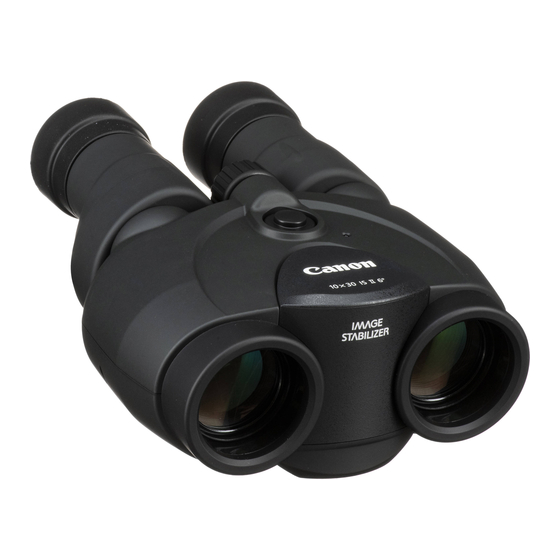Canon 10x30 IS II Руководство - Страница 10
Просмотреть онлайн или скачать pdf Руководство для Цифровая камера Canon 10x30 IS II. Canon 10x30 IS II 25 страниц. Technology guide
Также для Canon 10x30 IS II: Брошюра и технические характеристики (8 страниц), Брошюра и технические характеристики (8 страниц), Руководство пользователя (2 страниц), Руководство по эксплуатации (13 страниц)

Brightness varies from one model of binoculars to another.
Brightness varies with the price and size of the binoculars.
There are many degrees of brightness according to one' s needs.
1) Exit pupil
The bright circle visible when the eyepiece lens array is viewed
about 10 inches away from the eyes is called the exit pupil.
The diameter, measured in millimeters, is called pupil aperture.
The larger the exit pupil, the brighter an image the binoculars
make, and the brightness is expressed by the square of the
aperture of the exit pupil.
Human pupils are about 2-3 mm at most (Fig. 7-a) when bright,
and the binoculars' exit pupils should be about 3 mm. At night,
our pupils dilate to about 7 mm (Fig. 7-b), so it is desirable
to have binoculars with large exit pupils if they will be used
at night.
However, the disadvantage is that such binoculars tend to be
big and heavy.
When bright
When dark
2) Available Aperture of the Objective Lens
The diameter of the objective lens which the light passes
through is called the available aperture of the objective lens.
If the magnification is the same, the larger the available
aperture of objective lens, the brighter image seen through the
binoculars. This is the same effect as when a telephoto lens has
a very large lens diameter. The relationship of the three is:
Aperture of Exit Pupil =
(Fig. 7-a)
(Fig. 7-b)
Available Aperture of Objective Lens
Magnification
The exit pupil
is 3.0 mm
The exit pupil
is 7.0 mm
